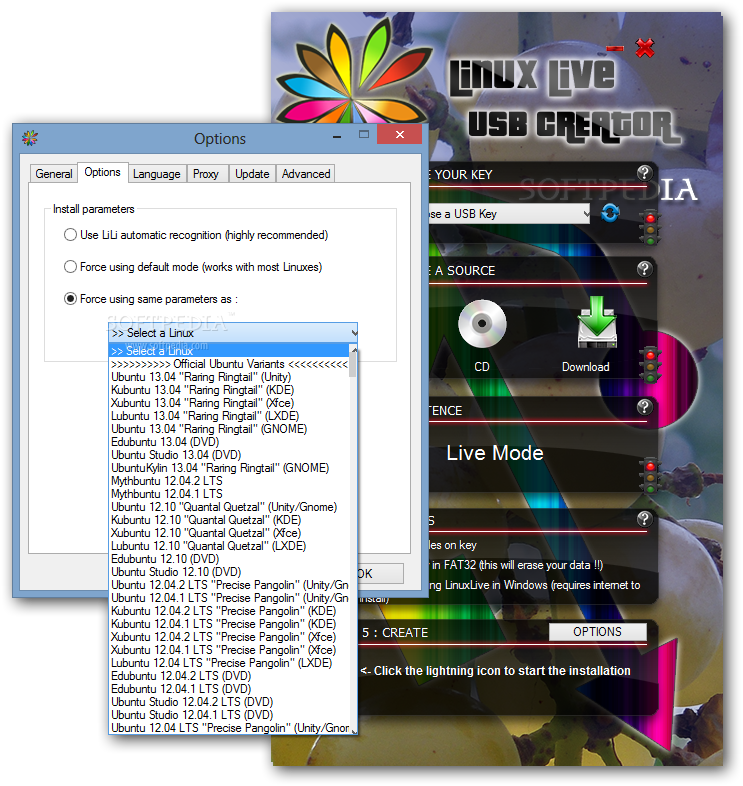

- #PCLINUXOS LIVE USB CREATOR DOWNLOAD INSTALL#
- #PCLINUXOS LIVE USB CREATOR DOWNLOAD FULL#
- #PCLINUXOS LIVE USB CREATOR DOWNLOAD SOFTWARE#
- #PCLINUXOS LIVE USB CREATOR DOWNLOAD PC#
- #PCLINUXOS LIVE USB CREATOR DOWNLOAD ISO#
#PCLINUXOS LIVE USB CREATOR DOWNLOAD INSTALL#
This program does not have an interface as such, but everything is done through a kind of installation wizard, as if we were going to install the program on our computer.
#PCLINUXOS LIVE USB CREATOR DOWNLOAD ISO#
PCLinuxOS MiniMe 2008 Compiz Screenshot: PCLinuxOS MiniMe 2008 USB installation: Download the MiniMe 2008 iso, burn the iso to a CD Boot from the CD. The good news is that were going to show you how correct these issues and get MiniMe installed and working. If we have a partition with persistence we can save all kinds of data in it so that they are not erased when finished. And the need to create an img for saving changes. This is because, generally, when we boot the system from the USB, when turning off the PC, all the data is deleted.
#PCLINUXOS LIVE USB CREATOR DOWNLOAD PC#
Restart your PC and set the system BIOS or Boot Menu. From the USB device, run makeboot.bat to make the drive bootable.


Move the contents from the PCLOS folder to your USB device. Navigate to that folder and run fixpclos.bat. Download PCLinuxOS ISO file and move it to the folder. We will also be able to create a USB with Windows, but this will not be installed as such, instead we will simply have an installation USB, just like the one that we can create with any other program.įinally, when creating our Live-USB with Linux we are going to be able to create a partition with persistence. Download and launch fixpclos.exe, a PCLInuxOS folder is created. Kon-Boot Other distros AOMEI (Disk Cloning and Backup Tool) Trinity Rescue Kit Other programs Falcon 4 Boot CD Sugar on a Stick Live-CD Antivirus AOSS (Malware Scanner) Here you can set any desired options and then click Go! to run the mylivecd command.Universal USB Installer Ubuntu Ubuntu Desktopīlackbuntu Linux Mint Linux Mint Debian Debian Netinstĭebian Live Kali Kali Linux Backtrack Backtrack Fedora Fedora Desktop OpenSUSE OpenSUSE 32bit Once installed you will find it on the main menu under Archiving->MyLiveGTK Search in Synaptic for mylivegtk to install the application and it's dependencies. Most failures of mylivecd are caused by not having enough space to create the remaster.įor those who prefer to use a graphical user interface there is a package called mylivegtk which provides a graphical front-end to the mylivecd command. The total for your root and home (plus any other system directories you have on a separate partition) should not exceed 60% of the free space you have in the root (/) filesystem. In the output, look under Used for the amount of space you have filled. To determine the size of your install and the amount of free space available, open a terminal and do: Also, if you do not have enough free space in your root directory (/), remastering will fail. If you try to remaster too large an install, remastering will fail.
#PCLINUXOS LIVE USB CREATOR DOWNLOAD FULL#
For a full list of the available options you do: Would exclude the Videos directory from the image. Mylivecd -nodir=^/home/terry/Videos myimage.iso For example, to keep the size of the ISO image manageable you may wish to exclude some files or directories from the image in which case you would add the -nodir option. In practice you may wish to include some extra options. This example also executes mylivecd with all options defaulted. Restoring Services on the installed systemĬreated 'myimage.iso' (1819,279,360 bytes) in 00:04:46 Setting filesystem parameters: Ĭreating compressed image: Ĭreating isolinux boot: Ĭreating UEFI boot image: Ĭreating final iso: Of the License, or (at your option) any later version.ĭisabling Services not needed on the LiveCDĬreating initrd:
#PCLINUXOS LIVE USB CREATOR DOWNLOAD SOFTWARE#
Modify it under the terms of the GNU General Public LicenseĪs published by the Free Software Foundation either version 2 This program is free software you can redistribute it and/or In this example the final ISO image will be called myimage.iso but you can call it anything you terry]# mylivecd myimage.iso The second command starts the process of creating the ISO. The first command unmounts all your other drives and partitions leaving just your root (/) and home (/home) partition mounted. Then you just need 2 commands to create your remastered ISO: The mylivecd tool is a command-line program which needs to be run as root so you will need to open a root terminal (or a normal terminal and then execute the su command) to reach a root prompt. You will also need to have the draklive-install package installed. If not already installed on your system then search in Synaptic for mylivecd. Your data partitions remain untouched provided that you only format the / (root) partition during reinstall. To keep the size of the image reasonable you may exclude specific files or directories (Videos, Music etc.) With /home on a separate partition, you can reinstall and keep all your settings and desktop tweaks. You can use an imaging program like ddcopy or K3B to create a liveCD/USB which you can install back to the same machine or another one. PCLinuxOS has a tool called mylivecd which can be used to make an exact copy of your system in the form of an ISO image which can be used in the same way as the PCLinuxOS installation media.


 0 kommentar(er)
0 kommentar(er)
